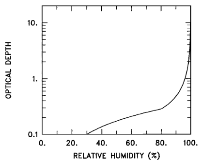Comments on “A limited-area-model case study of the effects of sub-grid scale variations in relative humidity and cloud upon the direct radiative forcing of sulfate aerosol”
- Pacific Northwest National Laboratory (PNNL), Richland, WA (United States)
HRD indicated that, because GCMs do not account for sub-grid scale variability in RH and its impact on water uptake and aerosol radiative properties, GCM estimates of direct radiative forcing are systematically too low. We suggest that, because water uptake is dominated by conditions that favor aerosol activation and produce cloud, the GCM estimates of direct radiative forcing may not be so far off. Direct radiative forcing within sub-grid scale clouds is likely to be negligible because so many of the aerosol particles in clouds are activated, and hence cannot contribute to direct radiative forcing (although activated aerosol material in cloud droplets still scatters sunlight, the effective radius of the cloud droplets is much larger than that of less than if the particles remained suspended aerosols).Correspondingly, however, there is the potential for indirect radiative forcing by these sub-grid scale clouds, and a GCM neglecting sub-grid scale clouds would neglect this contribution to indirect radiative forcing. The calculation of this indirect radiative forcing involves consideration of competition between natural and anthropogenic aerosol particles as cloud condensation nuclei and is beyond the scope of our comments. The reader should also consider that, because water uptake and aerosol activation are closely related processes, these conclusions depend little on the aerosol particle composition; although insoluble particles are less likely to be activated, water uptake is much less than for the more readily activated soluble particles. Thus, the conditions most likely to produce the greatest water uptake (high RH and large solubleable aerosol particles) are also those conditions most favorable for aerosol activation.
- Research Organization:
- Pacific Northwest National Lab. (PNNL), Richland, WA (United States)
- Sponsoring Organization:
- USDOE; NASA Mission to Planet Earth Program
- Grant/Contract Number:
- AC05-76RL01830; NAG5-4643
- OSTI ID:
- 1511457
- Report Number(s):
- PNNL-SA-29414
- Journal Information:
- Geophysical Research Letters, Vol. 25, Issue 7; ISSN 0094-8276
- Publisher:
- American Geophysical UnionCopyright Statement
- Country of Publication:
- United States
- Language:
- English
Web of Science
A limited-area-model case study of the effects of sub-grid scale Variations in relative humidity and cloud upon the direct radiative forcing of sulfate aerosol
|
journal | January 1997 |
The Delta-Eddington Approximation for Radiative Flux Transfer
|
journal | December 1976 |
A parameterization of cloud droplet nucleation part I: single aerosol type
|
journal | December 1993 |
Similar Records
Aerosol indirect effects ? general circulation model intercomparison and evaluation with satellite data
Aerosol indirect effects -- general circulation model intercomparison and evaluation with satellite data
